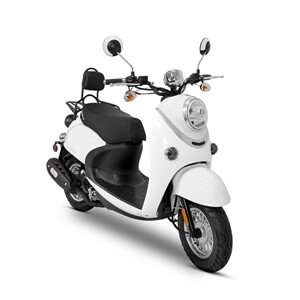How Much Does a Moped Cost?
With gas prices soaring, mopeds promise cheap, nimble transportation. But uncertainty around pricing holds many back from taking the plunge. This article provides cost clarity so you can decide if mopeds align with your budget or not.
Read on to find out about typical moped prices, cost structures, influencing factors, ownership expenses, money-saving techniques, and so on. We’ll explore both new and used options plus extras like safety gear. Whether commuting to work or just joyriding town, this article will give you realistic moped costs so financial fears don’t apply the brakes.
How Much Does a Moped Cost?
In the U.S. mopeds cost somewhere between $700 and $3,000 typically depending on size, age/condition, brand, and features. Cheaper Chinese models start at around $700. Name brands like Vespa and Honda cost $2,000+. Used mopeds offer significant savings but add maintenance considerations.
Most first-timers choose starter mopeds or scooters in the 50cc-125cc engine range, costing $900 to $1,500 new. Larger engines, fancier trim levels, and collectible vintage models reach up to $3,000. Electric models save on fuel costs but carry higher upfront pricing.
Moped prices on different websites
Red Fox Power Sports is one of the websites that offer gas scooters/mopeds with prices ranging from $1,349.95 to $1,449.95.
Another popular brand is Superior Powersports, which offers 50cc, 150cc, and 250cc mopeds and scooters from brands like Yamaha with prices ranging from $799 to $1,299.
NTX Power Sports also has motor scooters and mopeds for sale. Their prices prices range from $948 to $1,788.
We should also mention Q9 PowerSports, which offers 50cc, 125cc, and 150cc gas-powered scooters with prices ranging from $948 to $1,788.
How is the Moped Pricing Structured?
A moped’s total sticker price combines:
- Vehicle Cost: Determined by size, brand, age, condition, and features.
- Tax/Title Fees: Vary by state, often several hundred dollars.
- Insurance: Typically $200-$500 annually for basic liability coverage.
- Safety Equipment: Helmets, gloves, and jackets to provide protection.
- Maintenance: Tires, oil changes, and brake pads also add up over time.
Factors Influencing Moped Costs
Multiple factors affect moped pricing including:
- Engine Size – Larger engines equate to faster top speeds and improved power but also jump prices higher. 50-125cc suits most needs.
- Fuel Type – Gas models are the most common and affordable. Electric mopeds save on fuel costs but initial purchase prices prove higher.
- Age/Condition – Used mopeds balance lower prices with higher maintenance needs and worn parts.
- Brand Reputation – Chinese brands offer value pricing while Vespas carry a premium name-brand cache.
- Features/Accessories – Custom paint, performance upgrades, and storage add-ons increase costs.
- Supply/Demand – Moped popularity in the era of $5 gas keeps prices higher amidst inventory shortages.
With so many variables at play, be sure to compare moped models across multiple metrics to find the best value based on budgets and needs.
You might also like our articles about the cost of E-Scooters, Segways, or Onewheels.
Additional costs related to a moped
Even after purchasing your moped, you’ll encounter additional costs including:
- Licensing – Fees for licenses and registration range $50-$150 regionally.
- Gear – Quality helmets run $150+ while jackets, gloves, and storage cost extra.
- Insurance – Expect premiums of around $200-$500 for liability/collision policies.
- Maintenance – Oil changes, tire rotations, brake fluid replenishment, and other critical upkeep.
- Accessories – Custom parts for storage, lighting, farkles, and electronics add up.
- Safety Training – Consider professional instruction for safe operation, especially in traffic.
How can you save money?
If moped sticker shock steers you away, creative solutions exist:
- Buy used – Gently ridden models discounted 40% or more balance affordability and mileage concerns.
- Finance payments – Many dealers break costs into 12-36 month installment plans to ease burdens.
- Learn DIY maintenance – Oil changes, brake jobs and minor tune-ups reduce shop repair bills drastically.
- Compare insurance quotes – Leverage multiple carrier quotes to find the best rates.
- Seek winter deals – Off-season sales around October-February offer instant rebates.
Mopeds: More Than Just Transportation
 Beyond sheer affordability, riding a moped delivers joyful riding experiences unmatched by cars. You can feel the rush of wind against your face smelling fresh outdoor air. Maneuver narrow backroads cars can’t navigate, discovering hidden gems. Pull over on a whim for impromptu picnics in meadows. Wave at pedestrians and other riders, spreading smiles.
Beyond sheer affordability, riding a moped delivers joyful riding experiences unmatched by cars. You can feel the rush of wind against your face smelling fresh outdoor air. Maneuver narrow backroads cars can’t navigate, discovering hidden gems. Pull over on a whim for impromptu picnics in meadows. Wave at pedestrians and other riders, spreading smiles.
Mopeds foster simpler living, transporting you back to childhood’s carefree days. Leave stress at home and soak up relaxing rides that delight your soul. Adventure emerges around every turn when unencumbered by metal cages. Meander wherever impulse and imagination lead.
Form local clubs for group rides and mechanical talk. Bond over mutual passions at rallies and races. Embrace mopeds not just saving money but rediscovering youthful wonder hidden by life’s pressures. Ditch the constraining interstate for meandering scenic byways filled with possibilities. Let economic realities align with nostalgic joyrides into wide open horizons.
Frequently Asked Questions on Mopeds
Do you need a motorcycle license for a moped or motor scooter?
Moped licensing laws vary by state. Some classify mopeds as motor-driven cycles requiring motorcycle certification for models above 50cc. Others permit driving mopeds with just a regular driver’s license. Check your local DMV mandates. Taking a safety course looks great to insurance carriers.
What is the difference between a scooter and a moped?
Mopeds feature bicycle-like pedals allowing human-powered propulsion alongside motors. Scooters lack pedals, relying solely on engine thrust. Mopeds usually have smaller motors than scooters, with slower speeds topping around 30mph versus 65 mph for scooters. Legality definitions blur across states.
How far can a moped go on one tank of gas?
With engines under 100cc and tank capacities around 1 gallon, most mopeds can travel 60-100 miles on a tank depending on riding style. Conservatively estimate 60 gas miles per gallon to be safe. Carrying spare gas makes longer trips easier. Limit maximum ranges to under 150 miles for ideal reliability.


Leave a Reply
Want to join the discussion?Feel free to contribute!